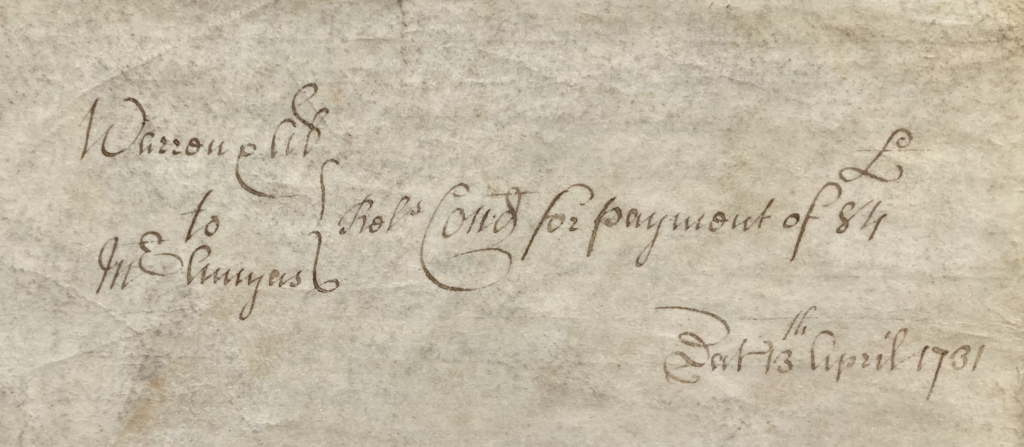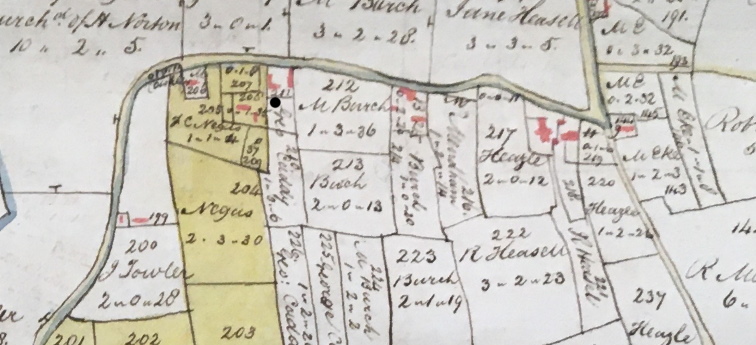History of a Small Farm in Bow Street
This is one of a series of blogs which tells the history of a small farm in Bow Street, Great Ellingham.
We begin at 1731.
Mortgage

Extract from the 1731 Indenture of Mortgage between Ann Warren, Thomas Thurlow & John Amyas. Courtesy Roger Banks
On the 13th April, 1731, Ann Warren and Thomas Thurlow mortgaged a property with land in Great Ellingham.
Widow Ann Warren and Thomas Thurlow both lived in Great Ellingham. However given that Ann once owned the property with her former (and late) husband, John Godward, I think it more likely that Ann Warren occupied the property. However it is, of course, possible that woolcomber Thomas Thurlow occupied at least part of the property
Nevertheless, Warren and Thurlow borrowed the sum of £84 plus interest from John Amyas, a gentleman, of Hingham.
Lease for a Year
The previous day, Ann Warren and Thomas Thurlow signed a ‘Lease for a Year’ with John Amyas. This Lease seems to have been used as a contract which bound Warren and Thurlow to enter into a subsequent Mortgage Deed with John Amyas.
Conditional Mortgage
The mortgage obligated Warren and Thurlow to repay 40s (forty shillings) on the 30th October, 1731. The balance of £82 to be paid on the 13th April, 1732, at the home of John Amyas in Hingham.

Extract from the 1732 Indenture of Mortgage between Ann Warren, Thomas Thurlow & John Amyas which shows the signature of Tho. Thurlow and the mark ‘X’ of Ann Warren. Courtesy Roger Banks
Ann Warren
I do not know what (if any) relationship there was between Ann Warren and Thomas Thurlow. However, what I do know is that Ann Warren had previously owned the property with her former husband, John Godward.
By the time Ann (as Ann Warren) mortgaged the property in 1731, her former husband was ‘long time deceased‘ and, of course, her later husband (probably Symon Warren) had also died.
The deeds also tell us that John and Ann Godward owned at least some of this land or property from at least 1691.
The Mortgaged Property
The Indenture of Mortgage recites the description of the whole property as follows:
One acre of land (be the same more or less) lying in Great Ellingham between the lands late of Isaac Harvey before that James Harvey in part towards the west and the lands now or late of George Cady towards the east and abut upon the land now or late of the said George Cady towards the north And also one Cottage with a Yard and Orchard thereto belonging and situate in Great Ellingham containing together by estimation half a rood with the appurtenances late parcel of a Messuage of one Joseph Harvey deceased as the said Cottage Yard and Orchard are situate and being in a street called Engate in Great Ellingham aforesaid next the residue of the said Messuage on the part of the west and the Pightle late of Richard Harvey to the east and abuts upon a Pightle there south and upon the Common Pasture of Great Ellingham towards the north And also one Tenement and three acres with the appurtenances lying in two several pieces whereof The First Piece containing by estimation one acre three roods parcel of a Tenement and three acres of land to the same Tenement belonging The Second Piece containing by estimation one acre one rood with the said Tenement thereon upon built called Newmans and lye together in Ellingham aforesaid between the lands now or late in the tenure of Ann Cady widow and Eglius Meare on the part of the east and the land late of James Harvey on the part of the west and abutting upon the Common Pasture of Ellingham aforesaid towards the north and upon the lands late of the said James [Harvey] towards the south
Where is the Property?
Unfortunately very few early deeds contain a plan or map. However, Indentures will include a full description of the property. Further (and probably to avoid confusion), it is also usual to find the same description repeated in subsequent deeds.
Therefore, the description used in the 1731 mortgage deed may well have been recited in much earlier deeds. Accordingly, James Harvey, Ann Cady, Eglius Meare, George Cady, Richard Harvey and Isaac Harvey, may well have owned neighbouring land or property much further back in time – possibly to the 1600s!
However, this does not answer the question – where is the property?
The answer is in the street we know today as Bow Street.

Extract from 1802 Map of Great Ellingham. Russell James Colman Plans. Cat. Ref. C/Ca 1/84. All rights reserved Norfolk Record Office. With kind permission of NRO
The black dot on the above extract from the 1802 Inclosure Map of Great Ellingham indicates the position of Warren and Thurlow’s property (with adjacent land to the south). The faint blue line running along the road, is the boundary of the Common Pasture of Great Ellingham.
We also know from the description recited in the Indenture of Mortgage that Bow Street was once known as ‘Engate’.
The Cottage
Today, the property is known as Holly Croft Farm.
At least part of Holly Croft Farmhouse is part of the premises mortgaged by Ann Warren and Thomas Thurlow in 1713. The farmhouse has, of course, undergone many changes over the last three hundred years or so.
It is also more than possible that given that the deeds recite the fact the John Godward acquired the premises in 1691, Holly Croft Farmhouse (or, at least part of it) has a much earlier history!
Owners and Occupiers after Ann Warren
Some three years after mortgaging the property to John Amyas, Ann Warren and Thomas Thurlow sold the property to Thomas Cady.
Sources:
Private Collection of Deeds to Property in Bow Street. Many thanks to Roger & Sue Banks
1802 Russell James Colman Plans. Great Ellingham. All rights reserved by Norfolk Record Office. Cat. Ref. C/Ca 1/84